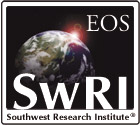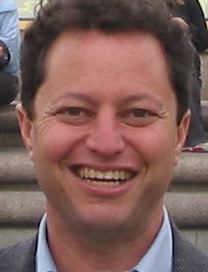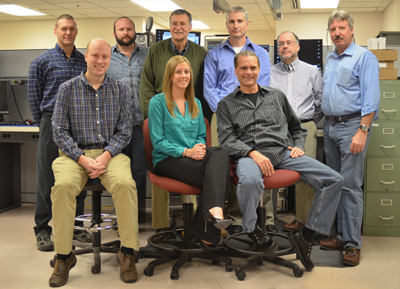Fall 2013
Space Science
WHEN THE SPACE SCIENCE CENTER won a lead role in NASA's large, four-satellite Magnetospheric Multiscale mission in 2005, it did so by cleverly meeting a requirement that barred research institutes without a specific funding and administrative infrastructure to participate in missions over $50 million—a requirement that UNH by itself could not meet.
 |
To finesse the $61 million contract to build instruments, electronics, and serve a key mission management role, UNH partnered with the Southwest Research Institute of San Antonio, Texas. SwRI, an independent, nonprofit applied research and development organization, had invested heavily to achieve the infrastructure mandated by the federal government—a system known as Earned Value Management—to participate in MMS.
The partnership was formally cemented for future joint research endeavors in the spring of 2013 when UNH's Institute for the Study of Earth, Oceans, and Space and Southwest joined forces to create the Southwest Research Institute Earth, Oceans, and Space Department, or SwRI-EOS for short.
The strategic move provides SwRI with access to principal investigators in both Earth and ocean science, which it currently lacks, as well as the skills of seven SSC engineers who are now employees of the newly created department. Additionally, as its only Northeast outpost, SwRI-EOS will provide Southwest with ready access to potential student interns, and perhaps even future employees, from UNH.
In 2005, the MMS mission represented the largest, single research award in UNH's history and the scope of the work was such that SSC scientists, program managers, engineers, technicians, and machinists have been flat out year after year.
But even back then, the changing landscape of the future was envisioned and initial groundwork began to prepare for times of leaner federal funding and stiffer competition for satellite missions. It was through such vision that SwRI-EOS was fashioned.
Today, with a good portion of the MMS work completed, no big replacement missions in hand or on the horizon, and federal funding agencies like NASA feeling the squeeze of sequestration and budget cuts, the joint venture is proving to be just what the doctor ordered.
"I've never seen anything like it before in my entire career," says SwRI-EOS director Roy Torbert in reference to the current situation at the federal level. But the long-time, now former, SSC director notes that with even greater challenges than anticipated, the creation of SwRI-EOS has already proven to be a win-win situation. "And that's because we've retained these UNH engineers and Southwest, had they not brought our people on board, would have had to hire outside people to work on their current missions building instrumentation under Department of Defense and commercial contracts."
The engineers—Paul Riley, David Bodet, Don Troop, Pieter Beckman, Steve Longworth, Steve Myers, and Kevin Mello—continue with space instrumentation projects begun prior to SwRI-EOS, but that now represents less than half their work.
EOS director Harlan Spence adds that, if anything, the current unexpected challenges have only reinforced the wisdom of formally joining forces with Southwest, which for years has partnered with UNH on numerous space science NASA missions, including most recently MMS, the Van Allen Probes, the Interstellar Boundary Explorer, or IBEX, and the Lunar Reconnaissance Orbiter, or LRO.
"From the beginning of our discussions with Southwest, the hope has been that there would be new programs coming down from federal agencies to provide opportunities for both them and us, as well as the united whole of SwRI-EOS," Spence says.
But the budget pressures in Washington, D.C. have put the brakes on new programs and, Spence notes, even in the best of scenarios for the decade ahead, big missions like MMS will be few and far between. These are the types of missions—done through contracts for flight deliverables rather than smaller NASA Supporting Research & Technology grants—that drive a full range of activities and support a team of project managers, engineers, and research scientists.
Says Spence, "The good news is that through SwRI-EOS we've been able to keep engineers with unique and important capabilities who would otherwise not be here due to missions winding down and the lack of replacement missions. So the partnership allows us to tap into resources and employees they have, and vice versa."
Small is beautiful
Despite the lack of big flight missions, both individual research institutes and SwRI-EOS as a whole will continue to have their fair share of SR&T grants to work on. Such grants drive the science, support active flight missions, and help develop the new generation of flight missions. Indeed, notes Spence, "For many people in the community, the grants are their meat and potatoes—they may never be involved in a flight mission directly but nevertheless contribute significantly to NASA's overall agency goals."
Also from the beginning of SwRI-EOS discussions, plans were being laid to supplant the lack of replacement missions for large NASA projects like MMS by focusing on smaller Earth Venture class missions—the equivalent of Explorer missions like IBEX but focused on Earth rather than space science. These are relatively low-to-moderate cost, small-to-medium-sized satellites that investigate aspects of the atmosphere, oceans, land surface, polar ice regions, and solid earth.
SwRI-EOS is, in fact, currently putting the final touches on an Earth Venture proposal that will achieve another targeted goal of the partnership—to bring in the "E" and "O" elements of EOS to Southwest's portfolio, which to date have been lacking.
Notes Spence, "Strategically, EOS itself wants to get more involved in NASA Earth science missions, and with SwRI-EOS, Southwest increases its capabilities through our principal investigators in the Earth Systems Research Center and the Ocean Process Analysis Laboratory. Southwest has a limited footprint in the Earth and oceans side of what we do, so combining forces allows us both to strengthen our proposals for these Earth Venture opportunities."
We are go for launch
Of course, the thinking all along has been that joining forces with Southwest would mean UNH could now participate in full-up Explorer missions as a lead institution now that it has the required infrastructural largess via partnership. That is, while UNH has critical roles in NASA Explorer missions like IBEX, Southwest has the lead science role in that mission by virtue of its Earned Value Management cachet.
So when the next round of NASA astrophysics Explorer mission opportunities rolls around a year from now, SwRI-EOS will put in a proposal for a full-up mission with the SSC's Mark McConnell as lead scientist, or principal investigator.
 |
|
| Cary Zeitlin Image courtesy of NASA/JPL-Caltech. |
That mission, the Polarimetry of Energetic Transients in Space, or PETS, is a scaled-up, follow-on to McConnell's balloon-based Gamma Ray Polarimeter Experiment. The PETS mission was proposed in 2012 under NASA's Mission of Opportunity program and would have flown the instrument on the International Space Station, but there were no selections at all for that solicitation because of the sequestration squeeze. For the next go-round, PETS will be a larger-scale mission on a dedicated satellite.
And joining forces has bolstered SSC science in another way: Southwest space scientist Cary Zeitlin is now part of the SwRI-EOS team (working remotely from SwRI offices in Boulder, CO and the San Francisco area) thereby adding a dimension that has been largely missing at UNH historically—planetary science.
Says Spence, "The planetary side of things is where we'd like to have more of a footprint, astrophysics, too, and those are both areas where there are probably more opportunities than we can currently tap into. Cary immediately adds a dimension of planetary science to what we do."
Even prior to SwRI-EOS, Zeitlin was part of the EOS team by virtue of his role in the LRO mission, specifically, the Cosmic Ray Telescope for the Effects of Radiation instrument for which Spence served as principal investigator. Zeitlin also has a leadership role on the science team for NASA's Mars Curiosity rover.
View from the other side
This coming January, Paul Riley will have worked nine years in the SSC, mostly on sounding rockets with associate professor Marc Lessard. Now a senior research engineer with SwRI-EOS, Riley says the transition has been largely seamless and much of his prior work continues, but there have been some required adjustments—welcome ones from his perspective.
"One of the big differences working with Southwest is that their involvement and expertise encompasses a really broad arena and, as engineers, this has already given us a chance to be exposed to some areas we might not necessarily have gotten here at UNH." He adds, "For me, it's always good to be exposed to different aspects of engineering and try to broaden your horizons."
Broaden indeed. SwRI is comprised of eleven technical divisions ranging from engine design and development, chemistry, electronics, space science, and more.Riley notes further that all the SwRI-EOS engineers come from different backgrounds; he has experience in the sounding rocket/ground instrumentation field, Troop and Beckman led engineering efforts in the EOS Climate Change Research Center before being integrated into space science projects, and Bodet, Longworth, and Mello all have experience working with the larger satellite projects, which is still a big portion of the work for SwRI-EOS employees. Myers serves a project management role.
Says Riley, "A lot of our group, actually with the exception of myself, are still quite involved in MMS, but we're starting to branch out into different projects, including those besides flight support." He adds, "Speaking from a personal perspective, SwRI is very supportive of technology development and we've been able to move forward on some projects we might not have been able to do on our own at UNH."
Technology development support has been provided in the past as well by Southwest on collaborative projects with UNH. For example, on joint projects, Lessard's sounding rocket group has been able to develop instrumentation in the early, proof-of-concept stage by using funds SwRI sets up rather than relying solely on grant funding.
Pushing the science forward
Such technology development is part and parcel of the SR&T work research institutes do and, EOS Director Spence notes, NASA has certain pools of money in various disciplines—be it planetary or astrophysics or heliophysics—dedicated to developing new instrumentation.
"At the heart of doing science, and a key part of our work as university researchers, is analyzing data from the current missions that answer the questions we knew to pose, but also posing new questions. And sometimes it's the new technology you develop that allows you to even think about posing that new science question," says Spence. Moreover, when researchers develop a new instrument to make a new key measurement, they often position themselves to potentially lead or at least be a significant partner in a flight proposal.
Referring to some of the missions both UNH and SwRI are involved in—from the Van Allen Probes to IBEX to LRO, Spence adds, "I'd say all our missions are pushing back the murkiness of the unknown, the mysteries of the universe, and leading to new questions. Here at EOS we have a critical mass of people that provides diversity of thought, opportunity, agency footprints, and approaches to similar science. We have complementary strengths that are numerous and deep, and the partnership through SwRI-EOS will serve to greatly enhance our individual and collective positions going forward."
